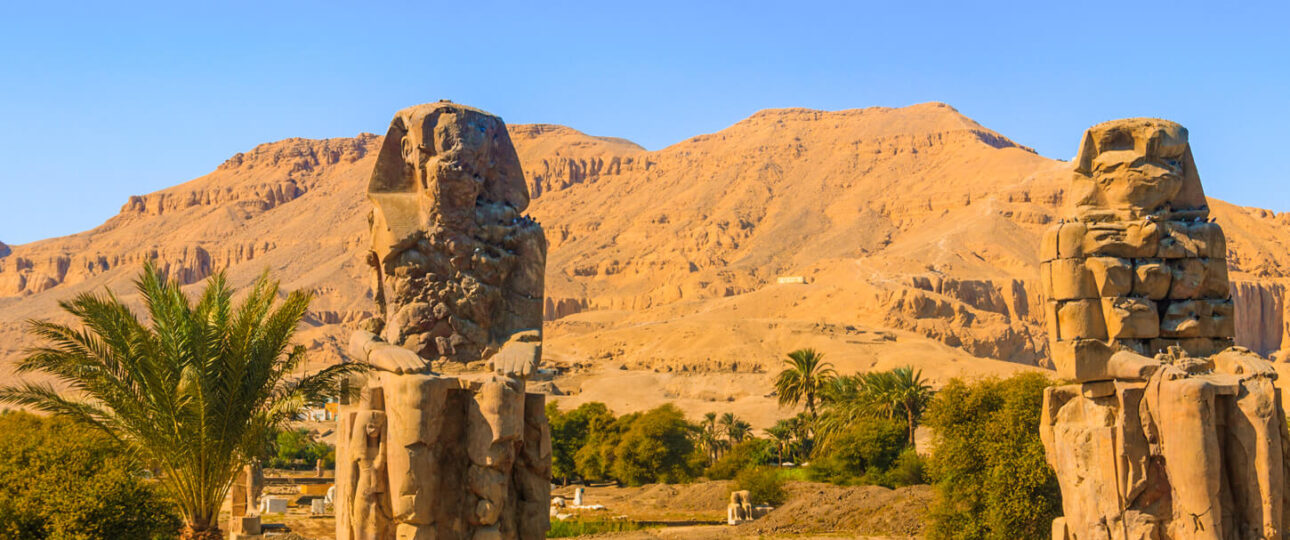Colossi of Memnon: The Giant Statues of Ancient Thebes
Embark on a journey to ancient Thebes and encounter the awe-inspiring Colossi of Memnon, two massive statues that have captured the imagination of travelers and scholars for centuries. Situated on the west bank of the Nile River near Luxor, Egypt, these imposing stone giants hold tales of ancient mythology and historical significance within them. This article will delve into the captivating world of the Colossi of Memnon, exploring their origin, legends, and enduring allure.
- Also Read Our Landmarks in Egypt
The Colossi of Memnon: Guardians of a Lost Temple
The Colossi of Memnon, also known as the “Vocal Memnon,” are two monumental statues made from single blocks of quartzite sandstone, each standing approximately 18 meters tall. These statues once flanked the entrance of the now-vanished Mortuary Temple of Amenhotep III, serving as guardians to the temple complex.
The Legend of the Singing Statues
One of the most intriguing aspects of the Colossi of Memnon is the ancient legend that claimed they produced melodious sounds at dawn. According to the myth, these sounds were the mournful cries of Memnon, the Ethiopian king and son of the goddess Eos, who was slain by the hero Achilles during the Trojan War. The singing statues became a renowned attraction for travelers and drew visitors from the ancient world.
The Roman Restoration and the End of the “Vocal” Phenomenon
In 27 BCE, an earthquake severely damaged the northern colossus, ending the “singing” phenomenon. Emperor Septimius Severus later ordered the restoration of the damaged statue, and it is said that he silenced the “voice” by filling the cracks in the stone with stones and cement.
The Hieroglyphics and Inscriptions
Both colossi are adorned with intricate hieroglyphic inscriptions detailing the accomplishments and religious beliefs of Amenhotep III. These inscriptions serve as invaluable historical records, shedding light on the life and reign of this influential pharaoh.
The Restoration and Conservation Efforts
Over the centuries, the Colossi of Memnon suffered from natural wear and human-induced damage. However, in modern times, dedicated conservation efforts have been undertaken to preserve these iconic statues, ensuring they stand tall as symbols of Egypt’s ancient heritage.
The Avenue of Sphinxes: A Lost Pathway
The Colossi of Memnon was once connected to the Mortuary Temple of Amenhotep III by an impressive Avenue of Sphinxes, adding to the grandeur of the temple complex. Sadly, much of the avenue now lies buried under the desert sands, waiting to be rediscovered by archaeologists.
The Colossi of Memnon in Ancient Travel Accounts
The Colossi of Memnon have fascinated travelers and explorers throughout history. Several accounts from ancient travelers, including Strabo and Pausanias, mention their encounters with the singing statues and their impressions of the colossal guardians.
The Colossi of Memnon Today: A Tourist Attraction
Today, the Colossi of Memnon continue to attract tourists worldwide, drawing visitors with their sheer size, intriguing legends, and historical significance. The statues remain as enduring symbols of the ancient wonders of Egypt.
FAQs about the Colossi of Memnon
What are the Colossi of Memnon?
The Colossi of Memnon are two colossal statues made of quartzite sandstone, once flanking the entrance of the Mortuary Temple of Amenhotep III.
Why are they called the “Vocal Memnon”?
They earned the nickname due to the ancient legend claiming that they produced melodious sounds at dawn, believed to be the cries of the slain Ethiopian king Memnon.
Is the “singing” phenomenon still present today?
No, the “singing” phenomenon ceased after an earthquake damaged one of the statues in 27 BCE, and Emperor Septimius Severus restored it.
What are the hieroglyphics on the colossi?
The hieroglyphic inscriptions on the colossi detail the accomplishments and religious beliefs of Pharaoh Amenhotep III.
Are there any restoration efforts for the colossi?
Modern conservation efforts have been carried out to preserve and protect the Colossi of Memnon from further deterioration.
Can tourists visit the Colossi of Memnon?
Yes, the Colossi of Memnon are open to tourists and serve as a popular attraction in Luxor, Egypt.
- Exploring the Rich Flavors of Egypt’s Traditional Food
Conclusion
The Colossi of Memnon are silent witnesses to the glorious past of ancient Thebes, guarding the remnants of a once-magnificent Mortuary Temple. As we contemplate their enigmatic history and the legends surrounding them, we are reminded of the enduring allure and mystery that shrouds these towering stone giants in the Egyptian desert.

